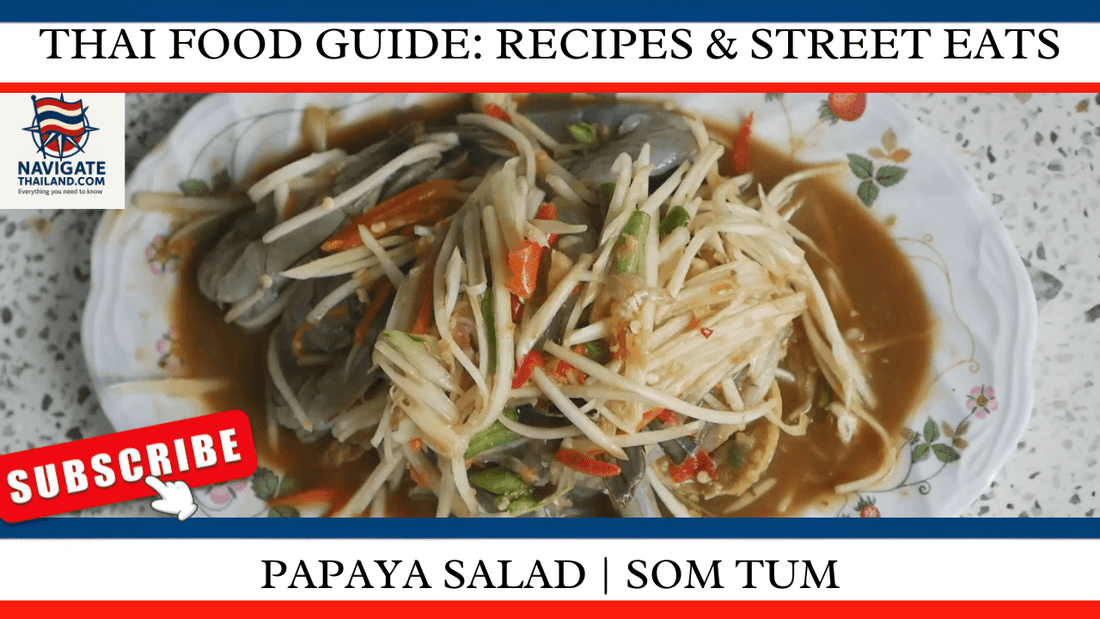
Papaya Salad: Thailand’s Green Papaya Salad Recipe You Need to Try
Share
Som Tum, or green papaya salad, is a staple of Thai cuisine that brings together the quintessential flavours of Thailand: spicy, tangy, sweet, and salty. Originating from Thailand’s northeastern Isaan region, Som Tum is a refreshing yet fiery dish that has captivated the hearts (and taste buds) of travellers and food lovers worldwide. It’s a nutritious, easy-to-prepare dish that offers a taste of Thailand’s vibrant food culture right in your kitchen.
Whether you’re planning a trip to Thailand or simply want to explore Thai food from home, this guide will show you how to make an authentic Som Tum and provide insights into its cultural and culinary significance.
A Little History of Som Tum
Som Tum has deep roots in the Isaan region of Thailand, a part of the country celebrated for bold flavours and unique ingredients. Traditionally, the dish was made with local ingredients like green papaya, and it gained popularity in central Thailand and Bangkok during the mid-20th century. Today, Som Tum is enjoyed across Thailand and Southeast Asia, often adapted with regional twists.
The name “Som Tum” comes from the Thai words “Som,” meaning sour, and “Tum,” which describes the pounding sound made while mixing ingredients in a mortar and pestle. While the classic version remains beloved, Som Tum has many variations, with additions like fermented fish, salted crab, or dried shrimp bringing unique tastes to each version.
Nutritional Value of Som Tum
Som Tum is a low-calorie, nutrient-dense dish packed with vitamins, fibre, and minerals. Here’s a general nutritional profile per serving (about 1 cup or 200 grams):
• Calories: 120 kcal
• Protein: 3 grams
• Carbohydrates: 25 grams
• Fat: 1 gram
• Fibre: 4 grams
• Vitamin C: 45 mg (50% of daily requirement)
• Vitamin A: 1100 IU (22% of daily requirement)
• Potassium: 300 mg
• Calcium: 30 mg
• Iron: 0.5 mg
Green papaya, the main ingredient, is high in digestive enzymes like papain, which aids digestion. The lime and tomatoes provide a healthy dose of Vitamin C, and the peanuts add small amounts of protein and healthy fats.
Ingredients for Authentic Som Tum (Serves 2-4)
• 1 medium green papaya, peeled and shredded (about 2 cups)
• 1-2 Thai bird’s eye chilies (adjust to your spice preference)
• 1-2 cloves of garlic
• 6-8 cherry tomatoes, halved
• 50 grams (¼ cup) green beans, cut into 1-inch pieces
• 2 tablespoons fish sauce (substitute with soy sauce for vegetarians)
• 2 tablespoons lime juice (about 1-2 limes)
• 1-2 teaspoons palm sugar (or brown sugar)
• 2 tablespoons roasted peanuts, roughly crushed
• 1-2 tablespoons dried shrimp (optional)
Fun Fact: Green papaya, unlike its ripe counterpart, has a mild flavour and firm texture, making it perfect for savoury dishes like Som Tum. Its digestive enzymes, particularly papain, are also beneficial for gut health.
Cooking Instructions
• Preparation Time: 15 minutes
• Total Time: 15 minutes
1. Prepare the Ingredients
• Peel and shred the green papaya using a julienne peeler or mandoline slicer for thin strips. Place the shredded papaya in cold water for a few minutes to keep it crisp, then drain and set aside.
2. Mix the Sauce
• In a large mortar and pestle, add the garlic and chilies. Pound them until roughly crushed. If you prefer less heat, remove the seeds from the chilies before pounding.
3. Add Vegetables and Flavour
• Add the green beans and cherry tomatoes to the mortar. Lightly pound to release juices and flavours without fully mashing them.
4. Season the Salad
• Add the fish sauce, lime juice, and palm sugar to the mortar. Use the pestle to mix, ensuring the sugar dissolves completely. The flavour should balance between spicy, sour, salty, and sweet.
5. Combine Papaya and Sauce
• Add the shredded green papaya to the mortar. Use a spoon and the pestle to gently mix, coating the papaya with the sauce.
6. Add Peanuts and Shrimp
• Toss in the roasted peanuts and optional dried shrimp, giving everything a gentle mix.
7. Serve and Garnish
• Transfer the Som Tum to a plate. Garnish with extra peanuts, lime wedges, or fresh herbs like cilantro.
Fun Fact: Som Tum is traditionally paired with sticky rice and grilled chicken (gai yang), making it a full meal. Locals also enjoy it with fried pork rinds for an extra crunch.
Serving Suggestions
Som Tum can be enjoyed on its own or as part of a larger Thai meal. Here are some ideas for an elevated experience:
1. With Sticky Rice: Sticky rice, or “khao niao,” balances Som Tum’s spiciness with its mild, chewy texture.
2. Grilled Meats: The salad’s acidity complements grilled meats like chicken or pork skewers perfectly.
3. Cabbage or Lettuce Wraps: Use cabbage or lettuce as wraps to scoop up Som Tum for a finger-food style snack.
4. Cold Drink: Pair with a cold beer or iced tea to cool down the spice.
Som Tum Variations
The classic recipe is a favourite, but several popular variations add new layers of flavour:
• Som Tum Thai: A milder version with more palm sugar and lime juice for a balanced sweet-sour taste.
• Som Tum Pla Ra: Known for its strong flavour, this version uses fermented fish sauce (pla ra) and is especially popular in Isaan.
• Som Tum Pu: Includes raw salted crab, which adds a briny flavour beloved by many in Isaan.
Nutritional Benefits of Som Tum
In addition to being delicious, Som Tum has impressive health benefits:
• Low-Calorie Option: At approximately 120 calories per serving, Som Tum is a light yet satisfying dish.
• Rich in Fibre: Green papaya provides dietary fibre, supporting digestion and promoting gut health.
• High in Antioxidants: The combination of tomatoes, green beans, and lime packs this dish with Vitamin C and other antioxidants that help boost immunity.
• Source of Protein: The peanuts and optional dried shrimp offer a modest protein boost, adding to its nutritional profile.
Conclusion
Som Tum is more than just a dish; it’s a culinary journey that encapsulates the best of Thai cuisine. Whether enjoyed as a quick snack, light meal, or part of a Thai feast, this green papaya salad delivers a perfect balance of spicy, sour, salty, and sweet flavours that’s bound to leave you craving more.
Have you tried making Som Tum at home? Share your experience, and if you enjoyed this recipe, spread the word by sharing it on social media. For more exciting Thai recipes, subscribe to our YouTube channel, where we share videos of our most popular blog recipes each week.
Let the taste of Thailand transport you—one delicious bite at a time!
References
1. Tourism Authority of Thailand. “Thailand’s Culinary Heritage.” Retrieved from tourismthailand.org.
2. David Thompson. Thai Food. (2002). Ten Speed Press.
3. Encyclopaedia Britannica. “Thai Cuisine.” Retrieved from britannica.com.
Read more of our Thailand blog series:
Thai Food Guide:Traditional Recipes and Street Eats
Everything Travellers Need to know
Thailand travel ebooks and language guides
Thailand Travel Apparel & Souvenir Gifts
Subscribe to our YouTube channel Navigate Thailand to see our most popular Thailand travel blogs turned into videos:
Navigate Thailand YouTube channel
















































































































































